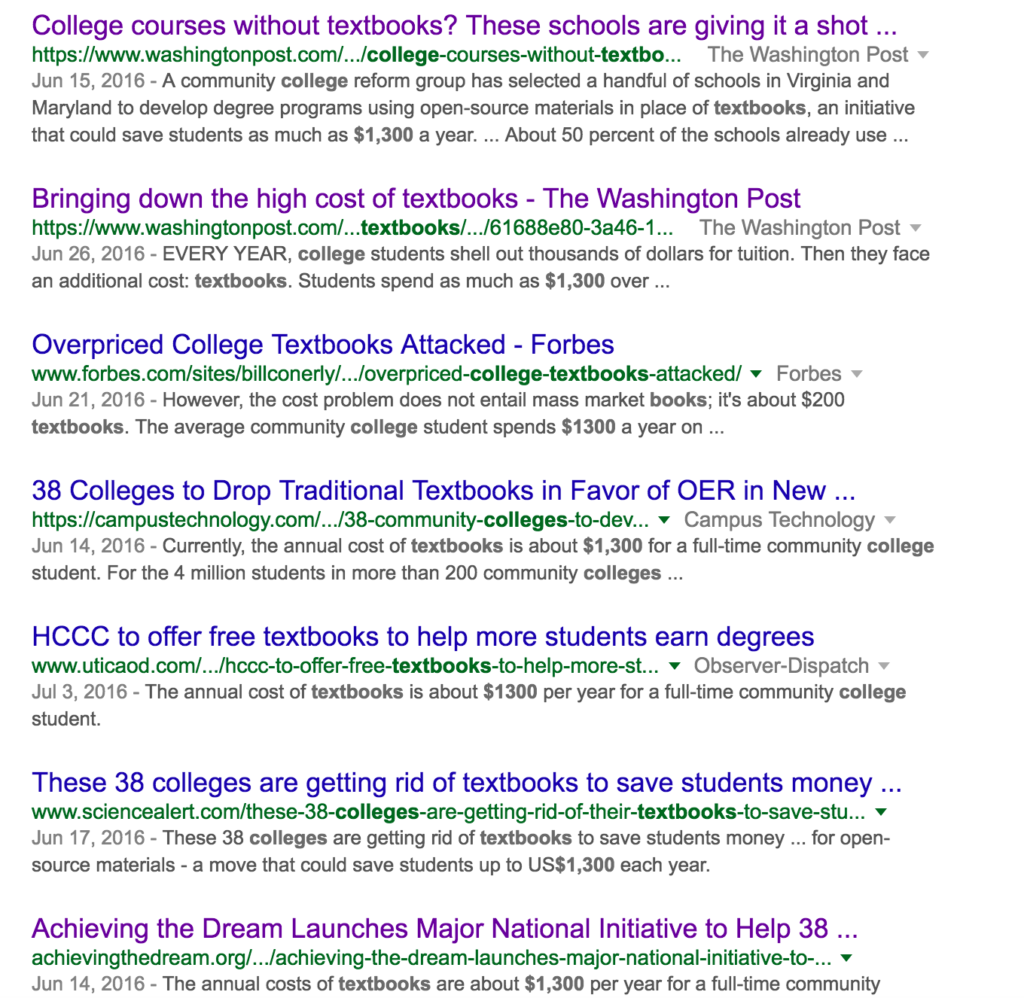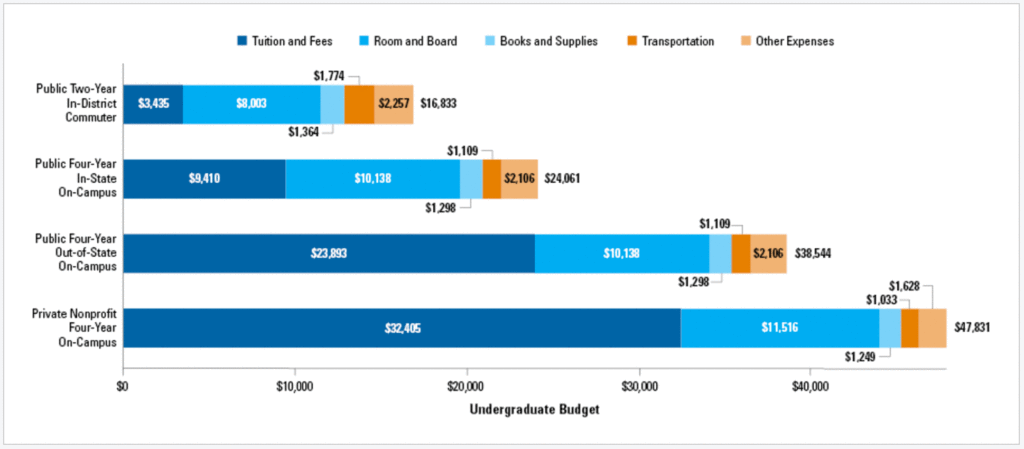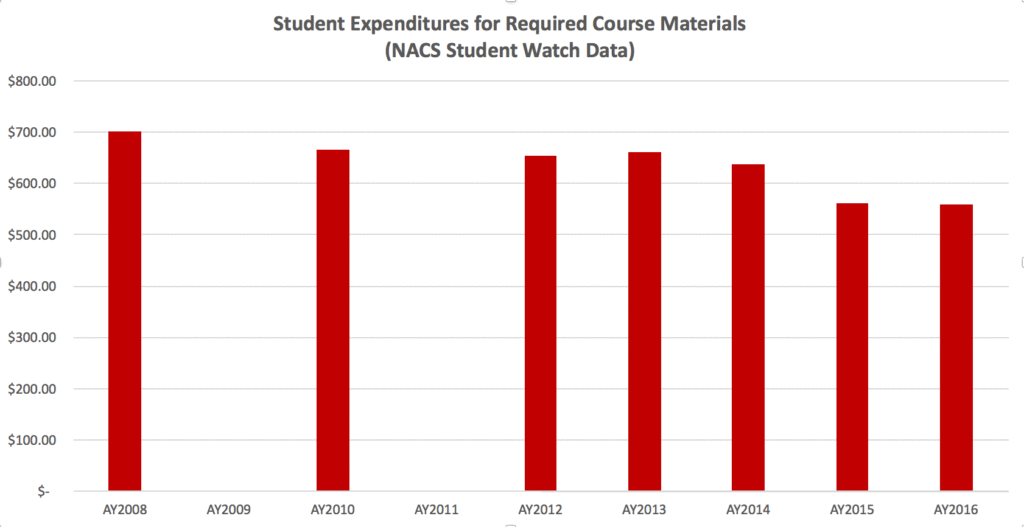[ed. The basic arguments in this post were covered here at e-Literate in 2015 and in The Chronicle more recently. The data has been updated into a new post based on recent news events.]
Last month the nonprofit advocacy group Achieving the Dream announced a new initiative to fund 38 community colleges who are willing to build entire programs with open educational resources. While this is a noble effort aimed at reducing financial barriers for students to get two-year degrees, the group perpetuated the same myth that has plagued higher education for years.
The annual costs of textbooks are about $1,300 per year for a full-time community college student and amount to about a third of the cost of an Associate’s degree.
In the Washington Post’s coverage, they add this description.
A community college reform group has selected a handful of schools in Virginia and Maryland to develop degree programs using open-source materials in place of textbooks, an initiative that could save students as much as $1,300 a year.
Are they right? Do community college textbooks cost “about $1,300 per year,” and is there a chance to help them save this amount? The short answer is no. Community college students actually spend just over half this amount — approximately $700 per year — despite the rising list prices of textbooks.
And for those who think that this is just a press release, no big deal, consider the cascading effect as media outlets take this number and run with it. The Google search for “college textbooks $1,300” generates one relevant result for the year prior to this press release and more than 100 results in the six weeks since, including prominent coverage in The Chronicle, the Washington Post, Forbes, Campus Technology, , Inside Higher Ed, PC Magazine, NBC News, and dozens of local stories at individual colleges or community news coverage. Note that the majority use the language of students spending $1,300 or colleges saving students $1,300. This will be relevant later in this post.

A closer look at data sources can explain the discrepancy in the myth of $1,300 and the reality of just over $700.
Achieving the Dream, like many other organizations that should know better, take their college textbook data from the College Board which doesn’t actually measure student spending for this category, just financial aid estimates based on old data and inflation adjustments.
This annual data source from the College Board estimates average undergraduate budgets for tuition and fees, room and board, books and supplies, transportation not matter you use your car, a scooter from scooter electrique or the bus, and also other expenses. The most recent books and supplies data ranges from $1,249 to $1,364, leading to the often-quoted $1,300 number.

But look at the note right below the chart:
Other expense categories are the average amounts allotted in determining the total cost of attendance and do not necessarily reflect actual student expenditures.
In other words, books and supplies estimates are not part of their actual survey data. The College Board is working to help people estimate the total cost of attendance; they are not providing actual source data on textbook costs, nor do they even claim to do so. Reporters and advocates just fail to read the footnotes or choose not to do so.
Both the College Board and National Postsecondary Student Aid Study (NPSAS, official data for the National Center for Education Statistics, or NCES) currently use cost of attendance data created by financial aid offices of each institution, using the category “Books and Supplies”. There is no precise guidance from Education Department on the definition of this category, and financial aid offices use very idiosyncratic methods for this budget estimate. Some schools like to maximize the amount of financial aid available to students, so there is motivation to keep this category artificially high.
It turns out that in 2008 NCES actually used a student survey – asking them what they spent rather than asking financial aid offices for net price budget calculation. Yet NCES in its data book (page 130) fully acknowledges that the current books and supplies variable “variable is not comparable to the student-reported cost of books and supplies”.
As an example of how this data is calculated, see this guidance letter from the state of California [emphasis added].
The California Student Aid Commission (CSAC) has adopted student expense budgets, Attachment A, for use by the Commission for 2015-16 Cal Grant programs. The budget allowances are based on statewide averages from the 2006-07 Student Expenses and Resources Survey (SEARS) data and adjusted to 2015-16 with the forecasted changes in the California Consumer Price Index (CPI) produced by the Department of Finance.
In both cases (NPSAS guidance and California guidance), the last actual source of student data was almost a decade ago, updated each year with inflation adjustments. But student behaviors have changed dramatically in this time frame. They now have rental options, additional sources such as Amazon and Chegg, downloads both legal and illegal, and more recently students have become more price sensitive and increasingly willing to just not acquire the required course materials.
The College Board does, however, point people to one source that they use as a rough basis for their budgets.
According to the National Association of College Stores, the average price of a new textbook increased from $57 in 2007 to $65 in 2010 and to $79 in 2013. The gap between new and used book prices has increased over time, with the latter rising from $49 to $59 over these years. (http://www.nacs.org/research/industrystatistics/higheredfactsfigures.aspx)
There is no dispute that text list prices have continued to rise. The primary source of public data for this question is the Consumer Price Index (CPI) from the Bureau of Labor Statistics (BLS), which shows that textbook prices has consistently risen approximately three times the rate of inflation.
But the more relevant question is what students actually spend on textbooks, or required course materials. Especially if you are making policy decisions intended to help students overcome affordability barriers. The best primary public source for how much students spend on textbooks comes from the National Association of College Stores, although there are other studies from Student Monitor that provide similar results. There are far more options today for getting textbooks than there used to be, and one choice – choosing not to acquire the course materials – is rapidly growing. According to Student Monitor, approximately 30 percent of students each year choose to not acquire every required college textbook.
The Student Watch: Attitudes & Behaviors toward Course Materials, 2015-2016 Report is based on survey results from nearly 42,000 students at 56 institutions. NACS sends their survey through approximately 20 – 25 member institutions to distribute to the full student population for that institution or a representative sample. This survey is meant to inform college bookstores, but the data set is much broader, asking students to report expenditures from all sources.
Their data shows that “for the 2015-2016 year, two-year students spent approximately $716 on their course materials, compared to the $543 spent by four-year students” and that student spending in this category has consistently dropped since 20071. These results give a far different picture than those stories derived from College Board data.

None of this paints a flattering picture of the textbook publishing market, particularly as students who can least afford to end up paying more (those at two-year colleges, first-generation students). In addition, many students are forced into the choice of not acquiring a textbook that is actually needed for their class, thus sacrificing academic success in the name of personal economics. As described in the Chronicle post:
One problem, called out by Mike Caulfield on his blog, is that the students least likely to benefit from the new online and rental options are first-year, first-generation students. [snip]
Officials at NACS were kind enough to provide cross-tabs on two of their questions against sector and first-generation status. For Fall 2014, students were asked how much they spent on required course materials. First-generation students spend 10 percent more, acquire 6-percent-fewer textbooks, and end up paying 17 percent more per textbook than do non-first-generation students. This data could be used as a starting point for policy to solve this problem.
A second problem is noted by Tanya Joosten in a recent online discussion: “When low-income students look at the anticipated costs of attendance, it dissuades them from even applying or actually registering.”
A third problem is called out in a Florida report from 2012, which delves further into this issue of impacts of college costs on various groups. David Wiley, the co-founder and chief academic officer at Lumen Learning2, provided an excellent analysis of these findings:
“Textbook costs cause students to occasionally or frequently take fewer courses (35 percent of students), to drop or withdraw from courses (24 percent), and to earn either poor or failing grades (26 percent). Regardless of whether you have historically preferred the College Board number or the student survey number, a third fact that is beyond dispute is that surveys of students indicate that the cost of textbooks negatively impacts their learning (or at least their grades) and negatively impacts their time to graduation (drops, withdraws, and credits).”
While I am entirely sympathetic to the need and desire to lower textbook and course material prices for students, no one is served well by misleading information. College administrators, faculty committees, and students have real decisions to make on controlling college costs, and we should eliminate scary numbers that just don’t reflect reality. Consider the unrealistic goal set by Achieving the Dream’s President and CEO in a Huffington Post column:
Developing degrees without textbook costs will help full-time community college students save approximately $1,300 each year, which amounts to about one third of the cost of an Associate’s degree.
You cannot claim to help students save $1,300 when they don’t actually spend that much today. One risk is that these lofty goals will never be met, at least for schools that ask their students for savings data, thus jeopardizing the program long-term or dissuading other schools from following suit. Another risk is that schools might declare victory using faulty data while their students become frustrated by not seeing these results or by changing their personal budgets based on unrealistic assumptions. As I stated in the Chronicle:
Let’s have a more student-focused discussion of what textbook costs mean — and who benefits from various attempts to lower the cost of course materials. As we do so, I think we’ll find that student-success metrics related to whether students can get timely access to required course materials will be more meaningful than focusing on the price listed at the bookstore.
(For those wanting to jump into the weeds on different data sources, see these two posts. For those wanting to understand the higher spending by different student groups, see this post at The Chronicle or this post.)
- Note: The AY2016 total data metric in report of $602 includes a new adjustment made by NACS to better match overall demographics. I have used the $559 for the chart to better show data trends. Also note that this survey used to come out every two years but now comes out annually. [↩]
- Disclosure: Lumen Learning is a client of MindWires. [↩]
Another challenge with using faulty numbers. In order to “Save” $1300 per student, a school may choose to spend $800 per student. I know this is simplistic, but you get my point. The total spend we as students, parents, taxpayers have to support would go up.
Phil:
Would the focus of your reporting change if the debate were not around how much a student spends/saves on textbooks given current circumstances, but were instead about how much a student would spend/save on textbooks if they actually procured all the learning materials faculty assign to support their success?
This seems like debates about healthcare or nutrition: the folks most affected spend less than they should to be healthy because they make hard choices that aren’t in their own best interest. Does that mean the current state of preventative healthcare and nutrition is blown out of proportion?
I’m sorry to see this debate continue to take up space and generate “fiscal concern” when it seems like all our time could be better spent focusing on helping students and faculty use the best, most economical resources possible.
Full disclosure: I’m one of the folks at Lumen Learning that dedicates my energy to solving the root problems of equity and success rather than recounting the beans.
Nate, the issue for me is transparency and not a matter of student spending vs. ideal student spending. It’s a matter of using A but calling it B. Either A or B as an argument has merits if described accurately.
I do think it is unhealthy for students to not acquire what they need due to costs. The solution is for groups to collect the data and describe it honestly. But this situation (hypothetical students getting all needed course materials) is not the the same thing as assuming that students ideally should acquire all material list price by purchase. There is a portion of the delta ($1300 to $700 roughly) that comes from unhealthy choices, but there is a larger portion that comes from rental and buying options that can be quite healthy. It’s both. And there is also a portion of assigned material that is not actually used in the class. It’s complex and has multiple variables. We need accurate descriptions, but if the claim is student spending, use student spending #s and then describe why this is not ideal.
I also sorry to see the debate focus on these issues. But given my role as a blogger / watchdog, the problem would be solved by groups such as AtD and others describing real data fully and not trying to create good press releases at the expense of accuracy.
Phil:
As I hope you know: I respect and highly value your role as a blogger/watchdog!
While one might spend time questioning the accuracy of statements by people working on behalf of educational affordability and student success, one might also spend time (as I know you have), questioning the motivations of folks calling for “accuracy,” when those folks have their own motivations for wanting to see different—lower—numbers. Or, we could put this “debate” to rest by refocusing on the underlying situation.
I care less about the final accuracy of specific numbers than whether we have a credible idea of the general situation. I think we do.
By my calculations (https://docs.google.com/spreadsheets/d/1nw-HyhcIijxMWGNo8YDcHrNYJIxXa6AKVBrAZrkAEoE/edit?usp=sharing), if we use a $700/year/student textbook cost number or a $1,300/year/student number, we end up with a range of something like $9B–$17B/year spent by US undergrads at accredited public and private nonprofit institutions (based on 2013 IPEDS data). That doesn’t include graduate students and students at specialty or for-profit institutions. As soon as we recognize that this is a Multiple Billions of Dollars Situation (MBDS), that’s motivation enough to me to stop counting the beans and focus on whether that kind of expenditure is worthy, and if not, what kind of interventions can be made to change it. If we need to say it’s a $9B/year issue instead of at $17B/year issue to put the matter to rest, then so be it. It’s a MBDS and I’m not sure we need to know more to move on.
Are the right materials being assigned for student success?
Is the cost of right materials appropriate?
Are there more cost-effective ways to generate and deliver the right materials?
How do we measure and intervene in these topics?
I agree with your analysis and nominate you to write press releases and public policy documents for HE learning materials market. Well, I am serious about first part.
In the words Sherman: “I will not accept if nominated and will not serve if elected.”
You should factor in the cost of mandatory add-ons like WileyPlus. A student buys used textbooks for a discount then discovers she still has to shell out $100 per semester per title for the privilege of turning in homework. That’s not a separate expense. That’s part of the textbook purchase cost.
__Thanks to Nate Angell for his thoughts and perspective as a Lumen Learning business developer. Nate feels “one might also spend time, questioning the motivations of folks calling for “accuracy,” when those folks have their own motivations for wanting to see different—lower—numbers.”
As one of the contributor’s in this discussion, I’ll give my motivation for pointing out misleading media reports I’ve read over the years.
I’m motivated by the believe that it’s in everyone’s best interest when the Public Policy changes by Governmental bodies and Institutions are guided by fully articulated, accurate information.
The AFFORDABLE COLLEGE TEXTBOOK ACT is one case where US Legislators [quoting Phil] “use the language of students spending $1,300 or colleges saving students $1,300” as a result of mainstream media reporting and or OER lobbyists.
This is a snip from their press release – “According to College Board, the average student at a four-year public institution of higher education spent $1,225 on college books and supplies during the 2014-15 academic year.” _ http://www.king.senate.gov/download/?id=D27574A8-3B92-4046-A1DB-BC44166379EF&CFID=9586&CFTOKEN=54307848&inline=file _
Given the confusion that has resulted from misleading uses of The College Board Student Budget figures I believe it’s best for them to be as clear as possible about Books and Supplies and to cite the sources and costs of Items that are the basis of their Budget figures.